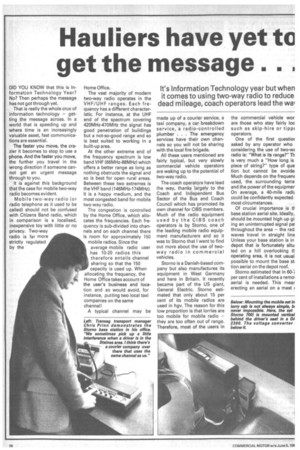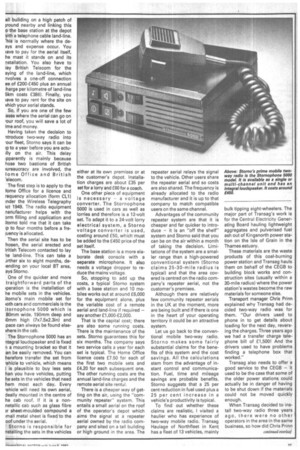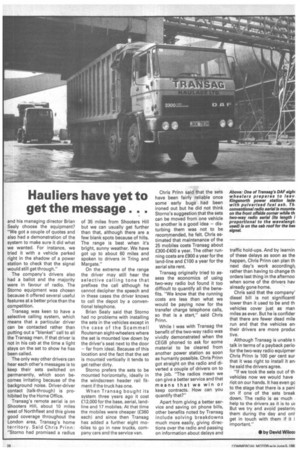Hauliers have yet to get the message . .
Page 24

Page 25

Page 26

If you've noticed an error in this article please click here to report it so we can fix it.
It's Information Technology year but when it comes to using two-way radio to reduce dead mileage, coach operators lead the wal
DID YOU KNOW that this is Information Technology Year? No? Then perhaps the message has not got through yet.
That is really the whole crux of information technology — getting the message across. In a world that is speeding up and where time is an increasingly valuable asset, fast communications are essential.
The faster you move, the crazier it becomes to stop to use a phone. And the faster you move, the further you travel in the wrong direction if someone cannot get an urgent message through to you.
It is against this background that the case for mobile two-way radio becomes evident.
Mobile two-way radio or radio telephone as it used to be called) should not be confused with Citizens Band radio, which in comparison is a localised, inexpensive toy with little or no privacy. Two-way radio is far more strictly regulated by the Home Office.
The vast majority of modern two-way radio operates in the VHF/UHF ranges. Each frequency has a different characteristic. For instance, at the UHF end of the spectrum covering 420IVIHz-470MHz the signal has good penetration of buildings but a not-so-good range and so is best suited to working in a built-up area.
At the other extreme end of the frequency spectrum is low band VHF (66MHz-88MHz) which offers a better range as long as nothing obstructs the signal and so is best for open rural areas. Between these two extremes is the VHF band (146MHz-174MHz). It is a happy medium, and the most congested band for mobile two-way radio.
The congestion is controlled by the Home Office, which allocates the frequencies. Each frequency is sub-divided into channels and on each channel there is room for approximately 150 mobile radios. Since the average mobile radio user has 10-20 radios this therefore entails channel sharing so that the 150 capacity is used up. When allocating the frequency, the Home Office takes account of the user's business and location and so would avoid, for instance, putting two local taxi companies on the same channel!
A typical channel may be made up of a courier service, a taxi company, a car breakdown service, a radio-controlled plumber . . . The emergency services have their own channels so you will not be sharing with the local fire brigade.
All these users mentioned are fairly typical, but very slowly commercial vehicle operators are waking up to the potential of two-way radio.
The coach operators have lead the way, thanks largely to the Coach and Independent Bus Sector of the Bus and Coach Council which has promoted its own channel for CIBS members. Much of the radio equipment used by the CIBS coach operators is by Storno, one of the leading mobile radio equipment manufacturers and so it was to Storno that I went to find out more about the use of twoway radio in commercial vehicles.
Storno is a Danish-based company but also manufactures its equipment in West Germany and here in Britain. It recently became part of the US giant, General Electric. Storno estimated that only about 15 per cent of its mobile radios are used in hgv. The reason for this low proportion is that lorries are too mobile for mobile radio — they are too often out of range. Therefore, most of the users in the commercial vehicle wor are those who stay fairly loc such as skip-hire or tippo operators.
One of the first questior asked by any operator who considering the use of two-m radio is: "What is its range?" Th is very much a "How long is piece of string?" type of que tion but cannot be avoid& Much depends on the frequem used, the surrounding terra and the power of the equipmer On average, a 40-mile radii could be confidently expected most circumstances.
Of crucial importance is base station aerial site. Ideally, should be mounted high up gi ing an uninterrupted signal pal throughout the area — the rad waves travel in straight line Unless your base station is in depot that is fortunately situ ted on a hill overlooking ft operating area, it is not usual possible to mount the base st tion aerial on the depot roof.
Storno estimated that in 60per cent of installations a rerna aerial is needed. This mear erecting an aerial on a mast I all building on a high patch of vound nearby and linking this o the base station at the depot vith a telephone cable land-line. his is normally where the deays and expense occur. You iave to pay for the aerial itself, he mast it stands on and its nstallation. You also have to lay British Telecom for the eying of the land-line, which nvolves a one-off connection ee of £200-£450 plus an annual :harge per kilometre of land-line 5km costs £386). Finally, you lave to pay rent for the site on vhich your aerial stands.
So, if you are one of the few ases where the aerial can go on 'our roof, you will save a lot of ime and money.
Having taken the decision to ntroduce two-way radio into 'our fleet, Storno says it can be ip to a year before you are actully on the air. This delay Ipparently is mainly because hose two bastions of British iureaucracy are involved, the tome Office and British 'elecom.
The first step is to apply to the tome Office for a licence and requency allocation (form CL1) inder the Wireless Telegraphy ■ ct 1949. The radio equipment nanufacturer helps with the orm filling and application and ;torn° told me that it can take ip to four months before a freluency is allocated.
Then the aerial site has to be hosen, the aerial erected and Iritish Telecom contacted to lay ae land-line. This can take a J rthe r six to eight months, deending on your local BT area, ays Storno.
One of the quicker and more traightforward parts of the iperation is the installation of he mobile sets in the vehicles. itorno's main mobile set for roth cars and commercials is the ;tornophone 5000 which is 80mm wide, 190mm deep and lOmm high (7x7.5x2.3in) and pace can always be found elsevhere in the cab.
The Stornophone 5000 has an ritegral loudspeaker and is fixed n a mounting bracket so that it an be easily removed. You can herefore transfer the set from 'ehicle to vehicle, which means t is plausible to buy less sets han you have vehicles, putting he sets in the vehicles that need hem most each day. Every rehicle will need its own aerial, deally mounted in the centre of he cab roof. If it is a nonnetallic cab such as glass fibre )r. sheet-moulded compound a ,mall metal sheet is fixed/to the oof under the aerial.
Storno is responsible for nstalling the sets in the vehicles either at its own premises or at the customer's depot. Installation charges are about £35 per set for a lorry and £60 for a coach.
One other piece of equipment is necessary — a voltage converter. The Stornophone 5000 is used in cars as well as lorries and therefore is a 12-volt set. To adapt it to a 24-volt lorry electrical system, a Storno voltage converter is used, costing around £50, which' must be added to the £450 price of the set itself.
The base station is a more elaborate desk console with a separate microphone. It also needs a voltage dropper to reduce the mains voltage.
So, stopping to add up the costs, a typical Storno system with a base station and 10 mobiles works out at around £6,000 for the equipment alone, plus the variable cost of a remote aerial and land-line if required — say another £1,000-£2,000.
That is the capital cost; there are also some running costs. There is the maintenance of the sets. Storno guarantees this for six months. The company says two service calls a year for each set is typical. The Home Office licence costs £7.50 for each of the first two mobile sets and £4.20 for each subsequent one. The other running costs are the annual land-line charges and the remote aerial site rental.
There is a cheaper way of getting on the air, using the "community repeater" system. This entails a small aerial on the roof of the operator's depot which aims the signal at a repeater aerial owned by the radio company and sited on a tall building or high ground in the area. The repeater aerial relays the signal to the vehicle. Other users share the repeater aerial and so costs are also shared. The frequency is already allocated to the radio manufacturer and it is up to that company to match compatible users on the same channel.
Advantages of the community repeater system are that it is cheaper and far quicker to introduce — it is an "off the shelf" system and Storno said that you can be on the air within a month of taking the decision. Limitations of the system are a smaller range than a high-powered conventional system (Storno claims 25-30-mile radius is typical) and that the area covered is centred on the radio company's repeater aerial, not the customer's premises.
Although there are relatively few community repeater aerials in the UK at the moment, more are being built and if there is one in the heart of your operating territory it could be an attractive system.
Let us go back to the conventional mobile two-way radio. Storno makes some fairly substantial claims for the benefits of this system and the cost savings. All the calculations stem from the advantage of instant control and communication. Fuel, time and mileage savings are probable benefits. Storno suggests that a 25 per cent reduction in fuel used plus a 25 per cent increase in a vehicle's productivity is typical.
To find out whether these claims are realistic, I visited a haulier who has experience of two-way mobile radio. Transag Haulage of Northfleet in Kent has a fleet of 13 vehicles, mainly bulk tipping eight-wheelers. The major part of Transag's work is for the Central Electricity Generating Board hauling lightweight aggregates and pulverised fuel ash out of Kingsnorth power station on the Isle of Grain in the Thames estuary.
These materials are the waste products of this coal-burning power station and Transag hauls them on behalf of the CEGB to building block works and construction sites (usually within a 30-mile radius) where the power station's wastes become the raw materials for someone else.
Transport manager Chris Prinn explained why Transag had decided two-way radio was for them. "Our drivers used to phone in to get details about loading for the next day, reversing the charges. Three years ago we had a transfer charge telephone bill of £1,5001 And the drivers used to have problems finding a telephone box that worked."
Transag also needs to offer a good service to the CEGB — it used to be the case that some of the older power stations could actually be in danger of having to be shut down if the materials could not be moved quickly enough.
When Transag decided to install two-way radio three years ago, there were no other operators in the area in the same business, so how did Chris Prinn and his managing director Brian Sealy choose the equipment? "We got a couple of quotes and also had a demonstration of the system to make sure it did what we wanted. For instance, we tried it with a vehicle parked right in the shadow of a power station to check that the signal would still get through."
The company's drivers also had a ballot and the majority were in favour of radio. The Storno equipment was chosen because it offered several useful features at a better price than the competition.
Transag was keen to have a selective calling system, which means that a particular driver can be contacted rather than putting out a "blanket" call to all the Transag men. If that driver is not in his cab at the time a light stays on the set to show he has been called.
The only way other drivers can hear each other's messages is to keep their sets switched on permanently, which soon becomes irritating because of the background noise. Driver-driver contact (talk-through) is prohibited by the Home Office.
Transag's remote aerial is on Shooters Hill, about 10 miles west of Northfleet and this gives good coverage throughout the London area, Transag's home territory. Said Chris Prinn: "Stomo had promised a radius of 35 miles from Shooters Hill but we can usually get further than that, although there are a few blank spots because of hills. The range is best when it's bright, sunny weather. We have got up to about 60 miles and spoken to drivers in Tring and Margate."
On the extreme of the range the driver may still hear the selective calling tone that prefixes the call although he cannot decipher the speech and in these cases the driver knows to call the depot by a conventional telephone.
Brian Sealy said that Storno had no problems with installing the sets in the vehicles except in the case of the Scammell Routeman eight-wheelers where the set is mounted low down by the driver's seat next to the door — far from ideal. Because of this location and the fact that the set is mounted vertically it tends to get rather dirty.
Storno prefers the sets to be mounted horizontally, ideally in the windscreen header rail fitment if the truck has one
When Transag bought its system three years ago it cost £12,000 for the base, aerial, landline and 17 mobiles. At that time the mobiles were cheaper (£360 each) and since then Transag has added a further eight mobiles to go in new trucks, company cars and the service van.
Chris Prinn said that the sets have been fairly reliable once some early bugs had been ironed out but he did not think Storno's suggestion that the sets can be moved from one vehicle to another is a good idea — disturbing them was not to be recommended, he felt. Chris estimated that maintenance of the 25 mobiles costs Transag about 000-C400 a year. The other running costs are £900 a year for the land-line and £100 a year for the aerial site rent.
Transag originally tried to assess the economics of using two-way radio but found it too difficult to quantify all the benefits. "We know that the running costs are less than what we would be paying now for the transfer charge telephone calls, so that is a start," said Chris Prinn.
While I was with Transag the benefit of the two-way radio was vividly demonstrated when the CEGB phoned to ask for some material to be cleared from another power station as soon as humanly possible. Chris Prinn got straight on the radio and diverted a couple of drivers on to the job. "The radios mean we can give a better service and that means that we win or keep contracts. How can you quantify that?"
Apart from giving a better service and saving on phone bills, other benefits noted by Transag include solving breakdowns much more easily, giving directions over the radio and passing on information about delays and
traffic hold-ups. And by learnin of these delays as soon as the .happen, Chris Prinn can plan th next day's work according!) rather than having to change th orders last thing in the afternoo when some of the drivers hay already gone home.
Chris said that the company' diesel bill is not significantl lower than it used to be and th vehicles cover just as man miles as ever. But he is confider that there are fewer dead mile run and that the vehicles an their drivers are more produc tive.
Although Transag is unable t talk in terms of a payback perio for the two-way radio equipmer Chris Prinn is 100 per cent sur that it was right to install it an' he said the drivers agree.
"If we took the sets out of th vehicles now we would have riot on our hands. It has even gc to the stage that there is a pani on if one of the sets break down. The radio is as much help to the drivers as it is to ut But we try and avoid pesterinl them during the day and onl get in touch with them if it i important."
• by David Wilco]


























































